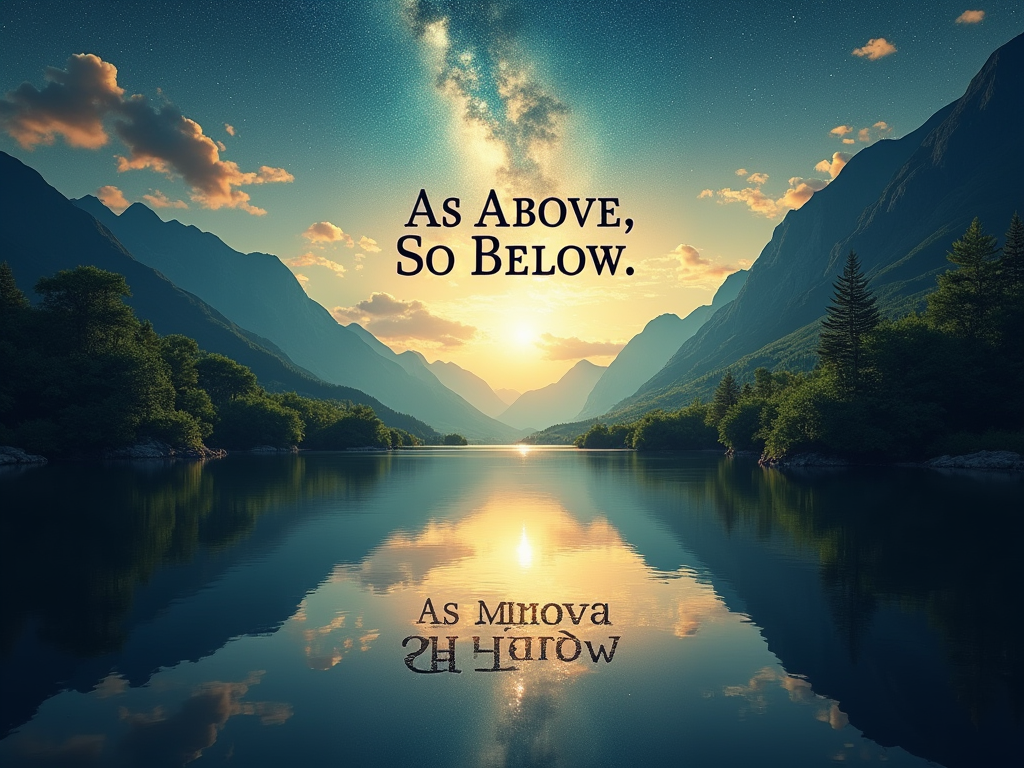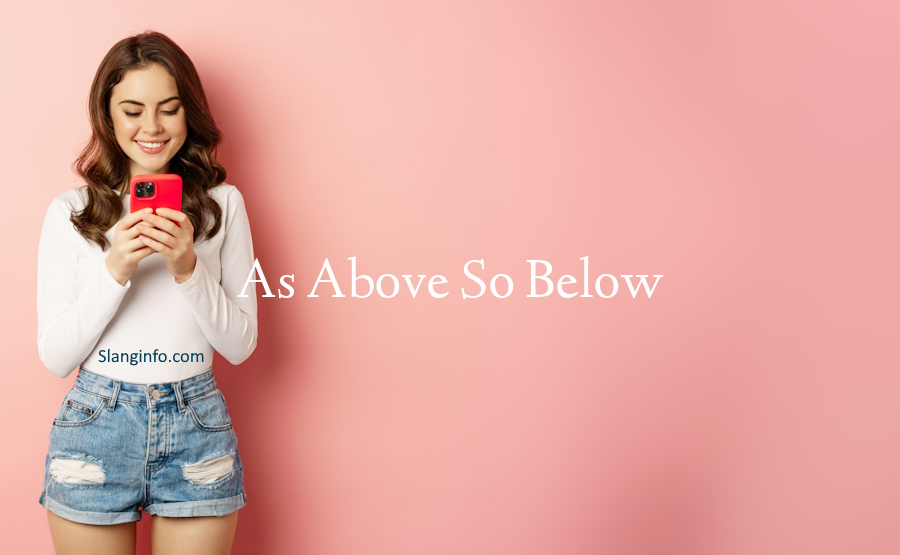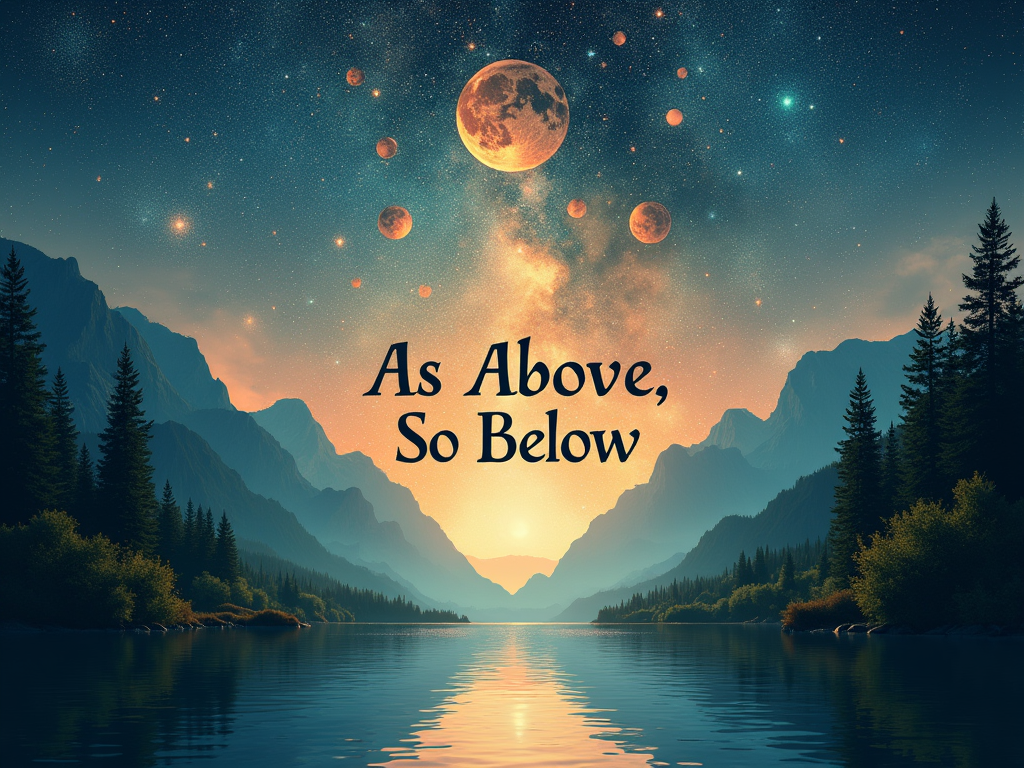Hey there, curious minds! 👋 Ever heard the phrase “As above, so below” and wondered what the heck it means? Well, you’re in for a treat! This ancient saying is like a secret code that’s been puzzling and inspiring people for centuries. It’s not just some random words thrown together – it’s a powerful idea that’s shaped everything from philosophy to science. So, let’s dive in and unpack this mystical phrase together!
| Key Takeaways |
|---|
| Ancient wisdom from the Emerald Tablet |
| Suggests a connection between the cosmos and our world |
| Used in philosophy, spirituality, and science |
| Influences modern thinking and pop culture |
| Encourages looking for patterns in life and nature |
As Above, So Below Meaning: Unraveling the Ancient Wisdom

What Does “As Above, So Below” Actually Mean?
Alright, let’s break it down. “As above, so below” is basically saying that what happens up in the sky (or in the big picture) is reflected down here on Earth (or in the small details). It’s like saying the universe is one big mirror, with everything connected and reflecting each other. 🪞
Here’s the deal:
- “Above” could mean the stars, the spiritual realm, or just big, universal ideas.
- “Below” is us, our world, our bodies, or the tiny details of life.
- The “so” part? That’s the magic connection between the two.
Think of it like this: ever noticed how the structure of an atom looks kinda like a mini solar system? That’s the kind of connection this phrase is talking about!
The Origin Story: Where Did This Come From?
Okay, storytime! 📚 This phrase didn’t just pop up in some fortune cookie. It’s got some serious history.
- The Emerald Tablet: This is where it all began. It’s an ancient text that’s supposed to contain the secrets of the universe. Pretty big deal, right?
- Hermes Trismegistus: This is the guy who supposedly wrote the Emerald Tablet. He was like the ancient world’s combo of a philosopher, priest, and king.
- Spread Through Time: From ancient Egypt to medieval alchemists, this idea has been passed down through the ages.
Fun fact: The original phrase was in Latin – “Quod est superius est sicut quod est inferius.” Try saying that three times fast!
How People Use It: From Magic to Science
Now, you might be thinking, “Cool story, bro, but what’s it got to do with me?” Well, this idea has snuck its way into all sorts of areas:
- Spirituality: Ever heard someone talk about “aligning your chakras with the universe”? That’s this idea in action.
- Science: Fractals in nature? That’s like “as above, so below” in math form!
- Psychology: Carl Jung (big-shot psychologist) used this idea to talk about how our minds work.
- Art: Next time you’re at a museum, keep an eye out. Artists love playing with this concept.
“As Above, So Below” in Everyday Life
Let’s get practical for a sec. How can you use this ancient wisdom in your day-to-day? Here are some ideas:
- Look for Patterns: Notice how your thoughts affect your actions, or how your room’s tidiness reflects your mental state.
- Problem-Solving: Stuck on a big problem? Try solving a smaller, similar one first.
- Self-Reflection: Think about how your personal experiences might reflect bigger life themes.
It’s like being a detective, but for life’s mysteries! 🕵️♀️
The Pop Culture Connection

This phrase isn’t just for dusty old books. It’s all over pop culture too!
- Movies: There’s literally a horror movie called “As Above, So Below.” Spooky stuff in the Paris catacombs!
- Music: Lots of artists drop this phrase in their lyrics. It’s like a shortcut to sounding deep and mysterious.
- Video Games: Game designers use this concept to create immersive, interconnected worlds.
Next time you’re binging your favorite show or jamming to some tunes, keep an ear out. You might catch this ancient wisdom popping up!
The Science Angle: It’s Not Just Woo-Woo
Now, I know what some of you might be thinking: “Isn’t this all just some new-age humblebrag?” But hold up! Science has some pretty cool things to say about this idea:
- Fractals: These are patterns that repeat at different scales. They’re everywhere in nature, from broccoli to coastlines!
- Quantum Entanglement: This weird physics thing shows how particles can be connected, no matter how far apart they are.
- Holographic Universe Theory: Some scientists think the whole universe might be like a giant hologram. Mind-bending stuff!
So yeah, it’s not just ancient philosophy – modern science is finding some truth to this “as above, so below” business!
Practical Applications: Using “As Above, So Below” in Your Life
Alright, let’s get down to the nitty-gritty. How can you actually use this ancient wisdom in your everyday life? Here are some practical tips:
- Mindfulness Practice: Next time you’re feeling stressed, try this:
- Take a deep breath
- Notice how your breath affects your body (that’s the “below”)
- Then, imagine how that calmness can spread to your whole day (that’s the “above”)
- Goal Setting: Think big, act small:
- Set a big, awesome goal (the “above”)
- Break it down into tiny, doable steps (the “below”)
- Each small win reflects your progress towards the big picture!
- Problem Solving: Stuck on a tricky problem? Try this:
- Look for similar patterns in smaller, easier problems
- Solve those first
- Apply what you learned to the bigger issue
It’s like being a life hacker, but with ancient wisdom as your secret weapon! 🛠️
Cultural Perspectives: It’s Not Just a Western Thing
You might think “As above, so below” is all about Western mysticism, but check this out:
- Eastern Philosophy: In Taoism, there’s this idea of balance between heaven and earth. Sound familiar?
- Indigenous Wisdom: Many Native American traditions talk about the connection between the spirit world and our world.
- African Spirituality: Some African cultures see a strong link between ancestors (the “above”) and the living (the “below”).
It’s like the whole world came to similar ideas, just expressed in different ways. Pretty cool, huh?
The Digital Age: “As Above, So Below” Goes High-Tech
Now, you might be wondering, “What’s this old-school philosophy got to do with our Y2K and beyond world?” Well, buckle up, because it’s more relevant than ever:
- Social Media: Your online profile (the “above”) often reflects your real-life persona (the “below”).
- Virtual Reality: VR worlds are being designed to mirror real-world physics and social dynamics.
- AI and Machine Learning: These technologies often mimic human thought processes and decision-making.
It’s like the ancient wisdom got a software update! 💻
Criticisms and Controversies: Not Everyone’s a Fan
Now, let’s keep it real. Not everyone’s on board with this “As above, so below” stuff:
- Scientific Skepticism: Some scientists argue it’s too vague to be meaningful.
- Religious Objections: Some religious folks see it as conflicting with their beliefs.
- Misuse in Pseudoscience: Unfortunately, some people use this idea to promote bogus theories.
Remember, it’s okay to be critical and ask questions. That’s how we learn and grow!
The Future of “As Above, So Below”
So, what’s next for this ancient idea? Here are some predictions:
- Integration with New Technologies: As we explore space and develop AI, we might find new ways to apply this concept.
- Interdisciplinary Studies: More researchers might use this idea to connect different fields of study.
- Personal Development Tools: We might see new apps or techniques based on this philosophy for self-improvement.
Who knows? Maybe you’ll be the one to come up with the next big application of this ancient wisdom!
Wrapping It Up: The Big Picture (and the Little Details)
So there you have it – “As above, so below” unpacked! It’s more than just a cool-sounding phrase; it’s a way of looking at the world that’s been inspiring people for centuries. Whether you’re into philosophy, science, or just trying to figure out your own life, this idea has something to offer.
Remember, the next time you’re slaying your goals or facing a tough challenge, think about how the big picture and the tiny details connect. You might just find some unexpected wisdom!
Got any thoughts on how “As above, so below” shows up in your life? Drop them in the comments below! And if you’re hungry for more mind-bending ideas, check out our articles on YOLO and POV. Keep exploring, keep questioning, and keep connecting those dots! 🌟🔍
P.S. Whether you’re totally vibing with this concept or still skeptical, remember: it’s all about finding what works for you. Use what resonates, leave what doesn’t, and always stay curious!







